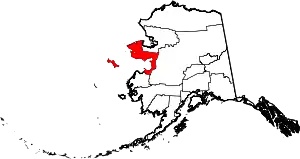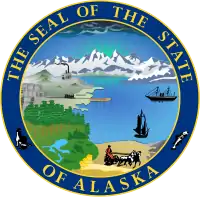Nome Census Area, Alaska
Nome Census Area (Russian: Ном зона переписи населения) is a census area located in the U.S. state of Alaska, mostly overlapping with the Seward Peninsula. As of the 2010 census, the population was 9,492.[2] It is part of the unorganized borough and therefore has no borough seat. Its largest community by far is the city of Nome.
Nome Census Area | |
|---|---|
.tif.jpg.webp) | |
 Location within the U.S. state of Alaska | |
.svg.png.webp) Alaska's location within the U.S. | |
| Coordinates: 64°44′N 164°11′W | |
| Country | |
| State | |
| Established | 1980[1] |
| Largest city | Nome |
| Area | |
| • Total | 28,278 sq mi (73,240 km2) |
| • Land | 22,962 sq mi (59,470 km2) |
| • Water | 5,316 sq mi (13,770 km2) 18.8%% |
| Population | |
| • Estimate (2019) | 10,004 |
| • Density | 0.41/sq mi (0.16/km2) |
| Time zone | UTC−9 (Alaska) |
| • Summer (DST) | UTC−8 (ADT) |
| Congressional district | At-large |
Geography
According to the U.S. Census Bureau, the census area has a total area of 28,278 square miles (73,240 km2), of which 22,962 square miles (59,470 km2) is land and 5,316 square miles (13,770 km2) (18.8%) is water.[3] It also includes the large offshore St. Lawrence Island, which has about 14 percent of the census area's population and two of its larger cities in Gambell and Savoonga. Nome Census Area is the 7th largest county-equivalent in the state of Alaska.
Adjacent boroughs and census areas
- Northwest Arctic Borough, Alaska - north
- Yukon-Koyukuk Census Area, Alaska - east
- Kusilvak Census Area, Alaska - south
- Chukotsky District, Chukotka Autonomous Okrug - west
National protected areas
- Alaska Maritime National Wildlife Refuge (part of the Bering Sea unit)
- Bering Land Bridge National Preserve (part)
- Yukon Delta National Wildlife Refuge (part)
- Andreafsky Wilderness (part)
Demographics
| Historical population | |||
|---|---|---|---|
| Census | Pop. | %± | |
| 1960 | 6,091 | — | |
| 1970 | 5,749 | −5.6% | |
| 1980 | 6,537 | 13.7% | |
| 1990 | 8,288 | 26.8% | |
| 2000 | 9,196 | 11.0% | |
| 2010 | 9,492 | 3.2% | |
| 2019 (est.) | 10,004 | [4] | 5.4% |
| U.S. Decennial Census[5] 1790-1960[6] 1900-1990[7] 1990-2000[8] 2010-2018[2] | |||
As of the census[9] of 2000, there were 9,196 people, 2,693 households, and 1,898 families living in the census area. The population density was 0.3 people per square mile (0.1/km2). There were 3,649 housing units at an average density of 0/sq mi (0/km2). The racial makeup of the census area was 19.32% White, 0.38% Black or African American, 75.20% Native American, 0.67% Asian, 0.02% Pacific Islander, 0.20% from other races, and 4.21% from two or more races. 1.00% of the population were Hispanic or Latino of any race. 16.32% reported speaking a Yupik language at home, while 8.75% speak Inupiaq; a further 2.02% reported speaking "Eskimo", a term that covers both Yupik and Inupiaq.[10]
Of the 2,693 households, 45.80% had children under the age of 18 living with them, 42.40% were married couples living together, 15.30% had a female householder with no husband present, and 29.50% were non-families. 23.20% of households were one person, and 3.30% were one person aged 65 or older. The average household size was 3.33 and the average family size was 4.01.
In the census area the population was spread out, with 37.10% under the age of 18, 9.30% from 18 to 24, 29.00% from 25 to 44, 18.60% from 45 to 64, and 5.90% 65 or older. The median age was 28 years. For every 100 females, there were 117.60 males. For every 100 females age 18 and over, there were 122.70 males.
Communities
Cities
Unincorporated communities
References
- In 1980, the United States Census Bureau divided the Unorganized Borough into 12 census areas.
- "State & County QuickFacts". United States Census Bureau. Archived from the original on May 19, 2014. Retrieved May 18, 2014.
- "US Gazetteer files: 2010, 2000, and 1990". United States Census Bureau. February 12, 2011. Retrieved 2011-04-23.
- "Population and Housing Unit Estimates". Retrieved May 11, 2019.
- "U.S. Decennial Census". United States Census Bureau. Retrieved May 18, 2014.
- "Historical Census Browser". University of Virginia Library. Retrieved May 18, 2014.
- "Population of Counties by Decennial Census: 1900 to 1990". United States Census Bureau. Retrieved May 18, 2014.
- "Census 2000 PHC-T-4. Ranking Tables for Counties: 1990 and 2000" (PDF). United States Census Bureau. Retrieved May 18, 2014.
- "U.S. Census website". United States Census Bureau. Retrieved May 14, 2011.
- MLA Language Map Data Center
